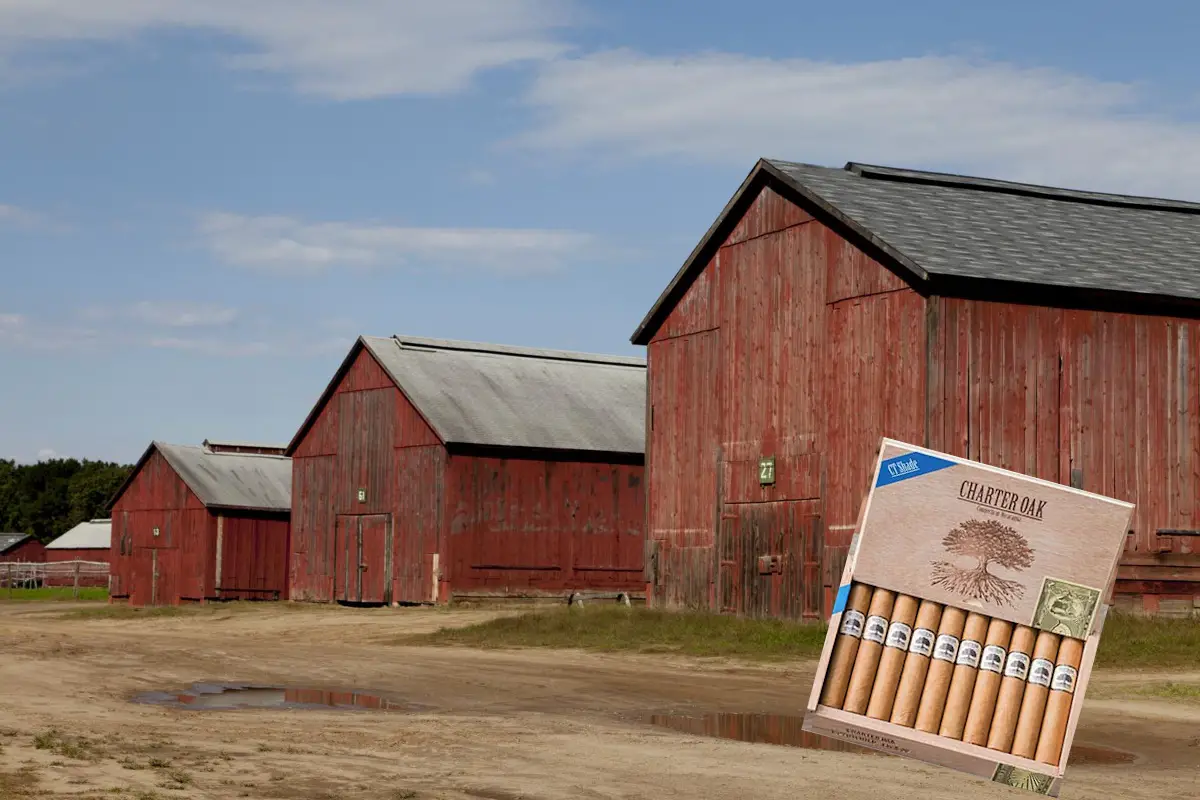The billowing white tents, once a feature of the northern Connecticut landscape, have almost disappeared, replaced by condos, parking lots and an Amazon warehouse. The vast acres of Connecticut Shade tobacco, 30,000 at their peak, have shrunk to just over 2,000.
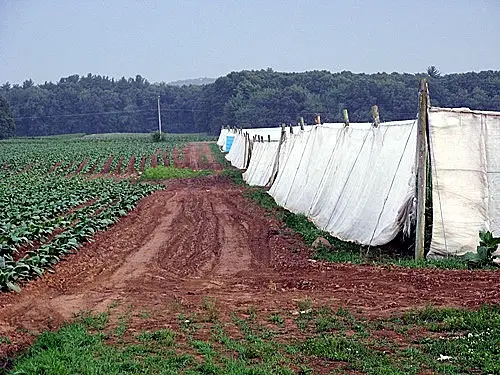
Connecticut Shade tobacco field
Cigar markers use Connecticut Shade as a wrapper – the outside of the cigar. It makes the finest wrapper in the world. As unlikely as it seems, Connecticut Shade ranks up there with tobacco from Cuba, Dominican Republic, Honduras, Mexico and Cameroon. Silky and golden, it looks good on a cigar.
The highly prized tobacco is one of the priciest agricultural commodities on the planet. The leaves must be perfect – no holes or imperfections – for the ultimate appeal to the cigar smoker. It therefore requires more labor than other kinds of tobacco.
The work begins in May, with weeding and transplanting seedlings. Then field workers fasten the plants to guide wires and spread cloth tents over them. As the plants grow, workers pick off shoots and tobacco worms. They harvest the leaves and bring them to sheds, where workers used to sew the leaves together and string them on wooden lathes. They’re hung up in the rafters where they cure, then they go to sorting sheds and warehouses.
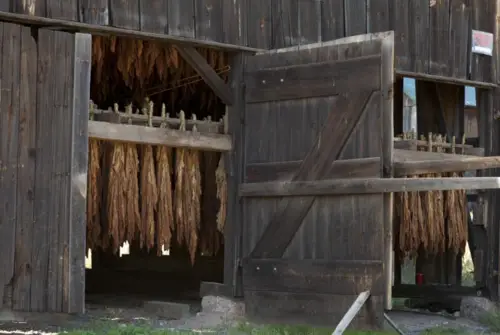
Connecticut Shade tobacco hanging in a barn
Here are some more fun facts about Connecticut Shade tobacco:
1. The first Connecticut Shade tent went up in 1901.
More precisely, it went up on River Road in Windsor, the epicenter of Connecticut Shade production.
Smoking tobacco began unknown centuries ago in Connecticut with Native Americans, who put it in their pipes and smoked it. In 1633, Europeans began to settle Windsor, and by 1640 they grew tobacco commercially. They brought their seeds from Virginia because it was better than the locally grown stuff.
For many years, a tobacco strain called Shoestring dominated the business, supplanted eventually by Broadleaf tobacco. As early as the 1820s, Connecticut tobacco was used for cigar wrappers. In 1875, growers upgraded to Havana seed, then later in the 19th century to Sumatra. Today, broadleaf and Havana Seed are used for binders, which hold the tobacco together. Shade goes outside.
Shade Tobacco resulted from years of crossbreeding Sumatra, Havana and Broadleaf. The cloth shade tents were found to cut sunlight and raise humidity, making thinner veins, a golden-brown color and a silkier leaf.
2. Soil good for tobacco growing is called Windsor soil.
Windsor belongs to Tobacco Valley, which stretches 60 miles from Portland, Conn., to the southern tip of Vermont. The valley’s hot, humid summers and deep, permeable soil make for ideal tobacco growing.

Tobacco field in Windsor, Conn.
The soil, formed in glacial meltwater sediments, is found all over the world. But no matter where it’s from, it’s called Windsor soil. The largest concentration of Windsor soil lies in the northern Connecticut River Valley, but it exists throughout the state. Connecticut has 34,000 acres of Windsor soil. Other crops like it too: fruit and vegetables, silage corn and ornamental shrubs and trees.
3. A Revolutionary War general introduced cigars to New England.
England attacked and occupied Cuba in 1762, kicking out Spain. Lt. Col. Israel Putnam, who owned a farm in Brooklyn, went on the expedition.
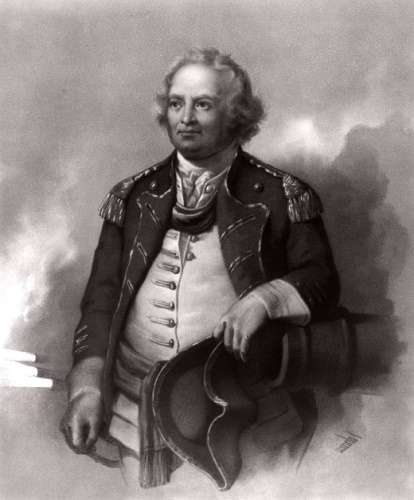
Israel Putnam
In 1763, Putnam returned to his Connecticut farm from Havana. He brought back cigar tobacco seed and more than 30,000 cigars. How much he brought is lost to history. Tobacco, though, has tiny, tiny seeds. You can put enough to plant 500 acres inside a lipstick tube. Three hundred thousand seeds weigh an ounce.
Putnam later won promotion to general and led troops in the American Revolution.
4. Cigar smoking once exceeded cigarette smoking.
The Golden Age of Cigars began around 1880 and lasted until World War II. The government helped it along around the time of the Civil War by reducing the cigar tax and loosening restrictions on what a cigar box could look like. Thousands of cigar factories sprang up around the country. At one time, the United States had a quarter million of them (granted, some small) making two million brands of cigars.
By 1885, Pennsylvania led the nation in the number of cigar factories with 4,658. New York came in a close second, with 4,495. Connecticut only ranked 13th. Hartford had 38, New Haven 28, New Britain 26, Suffield 20, Bridgeport 16, Norwich 14 and Waterbury 11. But the state’s tobacco industry employed many, many people in planting and harvesting the crop.
Eventually, cigarettes replaced cigars as the American smoke of choice.
5. Connecticut Shade growers importied workers after World War I.
Until World War I, Connecticut residents, including children and immigrants from Lithuania, Poland and Italy, made up a large enough workforce to grow the state’s Connecticut Shade crop. That changed when the war broke out. People joined the armed forces or went to work in the lucrative munitions factories. That began decades of importing labor from outside.

Picking tobacco in Gildersleeve, Conn.
The first attempt to bring in outside labor failed spectacularly. In December 1915, the Connecticut Tobacco Company ran an ad in the New York World looking for 500 women to sort tobacco leaves. The women who answered the ad turned out to enjoy male attention. Their promiscuity allegedly “demoralized Hartford.”
The growers then recruited southern Blacks, Jamaicans, Barbadians and Trinidadians. After World War II, Puerto Ricans came to work in the fields..
6. Martin Luther King worked on a Connecticut Shade tobacco farm.
At 15, Martin Luther King Jr, worked in the tobacco fields to earn money for his tuition at Morehouse College. The school had an arrangement with Cullman Bros., which hired Morehouse students to work through harvest.
Young King (who then went by his birth name, Michael) spent the summer working in Simsbury. He found the experience liberating. He could worship with white people in church, eat in the same restaurants and sit in the same train car. Three years later he came for another summer.
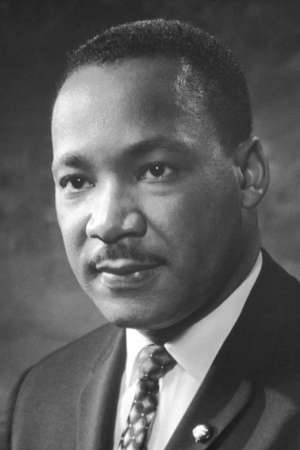
Martin Luther King during a 1964 news conference
Others who worked the fields and then found success in life included tennis star Arthur Ashe, gospel singer Mahalia Jackson, U.S. Supreme Court Justice Thurgood Marshall and film actress Hattie McDaniel
7. Preservationists are trying to save the old tobacco barns.
Development pressure, competition and public health campaigns eat away at Connecticut Shade farms and barns. William Thrall, for example, started the family farm in 1646. Around 1900, his descendant Oliver Thrall started growing Shade tobacco under cloth tents.
For more than 100 years, the farm mainly grew Connecticut Shade tobacco. But in the early 21st century the farm faced competition from Honduras and Ecuador. Farmers there grow “Connecticut seed” tobacco, paying their workers much less than Connecticut growers pay theirs.

Connecticut Shade tobacco barn in Suffield
Antismoking campaigns also shrunk the market for cigars and cigar wrappers.
Around 2015, brothers Spencer and Joseph Thrall, who ran the 600-acre family farm began to grow barley, wheat and other grains.
Other tobacco growers sold their land around Bradley Airport and along Interstate-91 to developers. Down came the iconic tobacco barns and up went the condos and warehouses.
Connecticut Shade tobacco barns are among the historic structures Preservation Connecticut aims to identify and save. Check out The Barns Project here.
Images: Tobacco leaves: Highsmith, C. M., photographer. (2011) Tobacco barns in Windsor, Connecticut. Windsor United States Connecticut, 2011. October. [Photograph] Retrieved from the Library of Congress, https://www.loc.gov/item/2012630858/. Barn door Highsmith, C. M., photographer. (2011) Tobacco barns in Suffield, Connecticut. Connecticut United States Suffield, 2011. October. [Photograph] Retrieved from the Library of Congress, https://www.loc.gov/item/2012631001/. Three Barns, Highsmith, C. M., photographer. (2011) Tobacco barns in Windsor, Connecticut. United States Windsor Connecticut, 2011. October. [Photograph] Retrieved from the Library of Congress, https://www.loc.gov/item/2012630833/. Tobacco field in Windsor, United States Resettlement Administration, Locke, E., photographer. (1937) Tobacco field, Windsor Locks, Connecticut. Windsor Locks Connecticut United States, 1937. Sept. [Photograph] Retrieved from the Library of Congress, https://www.loc.gov/item/2017728708/.
